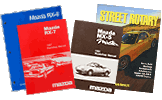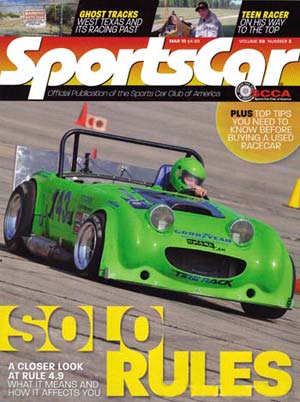
Going Solo
Rotary Racer Jeff Kiesel
- Solo 2 National Championships:
- 2006 BP Mazda RX-7
- 2007 EM '58 3ROTOR Sprite
- 2008 EM 2008 KFR Turbo Sprite
- 2009 EM 2008 KFR Turbo Sprite
- 2010 EM 2010 KFR Turbo Sprite
- 2011 EM 2010 KFR Turbo Sprite
- 2012 EM 2010 KFR Turbo Sprite
- Pro Solo National Championships:
- 2007 M1 (EM) '58 3ROTOR Sprite
- 2008 M1 (EM) 2008 KFR Turbo Sprite
- 2009 M1 (EM) 2008 KFR Turbo Sprite
- 2010 R1 (EM) 2010 KFR Turbo Sprite
- 2011 R1 (EM) 2010 KFR Turbo Sprite
- 2012 R1 (EM) 2010 KFR Turbo Sprite
During a busy day at the track we had an opportunity between runs to sit down and chat with Racing Beat-sponsored driver Jeff Kiesel. The rotary-powered Kiesel Family Racing Sprite is certainly a fan favorite for good reason; it's wickedly fast and thrilling to watch. Here's our conversation with Jeff:
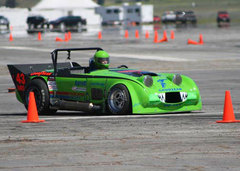 |
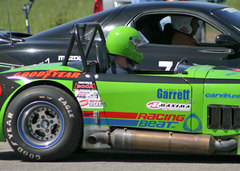 |
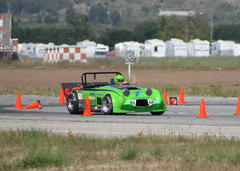 |
It seems that everyone in your family is a racer; tell us a little about the family lineup.
My dad, Mark Kiesel is my co-driver and races in the E-modified open class with me using the same car. My wife Shawn races in the E-modified ladies class using the same car and she's won national championships in 2008 and 2010. In 2006 we also both won in our tube-frame, carbon-fiber bodied 1993 RX-7 that I built in our garage. Coming up next is our son, Zak Kiesel, who races a 100 cc Yamaha go-kart in Formula Junior B class. Following next is our daughter Kaila who races her own 80cc Yamaha kart.
How did you come to select the Austin Healey Bugeye sprite as your race vehicle?
In our class you want to have a car with a short wheelbase that has enough room to get what engine package, rear end package, and transmission package in the car that you require. The short wheel base of the Sprite is critical to getting the car to rotate and transition very fast through the turns.
I purchased the car as an autocross race-prepped car that was already equipped with a 3-rotor peripheral port engine. I bought the car in 2006 for good price and it was already a proven winner with 3 national championships under its belt. It needed a lot of work and I came to Racing Beat for guidance with the right engine package for the car.
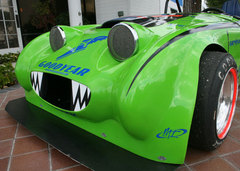 |
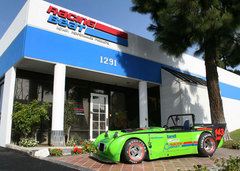 |
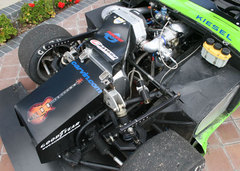 |
What's with the teeth on the front of the car?
I wanted to make the car look a little mean. Everyone always says the Bugeye is so "cute", especially the girls. So, I put the teeth on the car and I haven't had a cute comment since!
How about the wild green paint scheme?
The color scheme was my idea, when I purchased the car it was white and I wanted something that popped out and stood out for sponsors. "Look at me, I'm over here!", that's the color green it is!
Why did you decide to switch from the 3-rotor peripheral port engine to a 2 rotor turbo engine?
Looking at the power curve of the 3-rotor peripheral port engine we noticed that it had just modest low end power. Also, the consideration of switching to the Racing Beat aluminum housings would reduce the weight of the engine by 100 lbs. The benefits of the 2-rotor also had the advantage of more horsepower and torque lower in the RPM range. While the original 3-rotor engine made 400 HP to the wheels (270 ft/lbs torque) , the new 2-rotor engine that we've installed produces 380 HP to the wheels (310 ft/lbs torque). The power band of the new engine is over a broader RPM range (4000-9000 RPM), while power band of the prior 3-rotor engine was much narrower.
The new engine is an all aluminum 2-rotor 13B with a street-port intake. The internals consist of the Racing Beat Super Lightweight High compression rotors, Ceramic Apex Seals, the RX-8 eccentric shaft, Mazda Competition Oil Dry Sump, the Racing Beat water-jacket water modification rotor housings, custom-made Racing Beat intake manifold with a single throttle body, a Garret GTX3071 turbo, MOTEC Engine management, and Racing Beat's stationary gears.
What brought you to contact Racing Beat for assistance with your engine project?
The reputation of Racing Beat was my foremost consideration, Racing Beat has had a great name in all forms of racing, especially with regards to the aluminum rotor housings. I wanted to drop the weight of the engine and there were no other options, and with Racing Beat's reputation being so good I figured why not let guys just build the motor!
We switched to this engine in the beginning of 2008 and run approximately 30 events a year, in total we have run this engine in over 130-140 events. It's been great, it's been nothing but good success with this engine.
Did you tell Jim Mederer, Racing Beat's co-founder and chief engineer, exactly what you wanted for your engine, or did you list your goals and ask him to build an engine to meet your requirements?
I went to Jim, and I didn't take him a core engine, and I told him to build me a brand new engine. I didn't want him to use any used parts, I wanted all new parts every single nut, bolt... everything in the motor. So, I didn't bring him an old oily greasy engine and tell him to "Fix this," I said, "Build me something". I told him I needed usable power at 4000 RPM and need it to rev to 9200 RPM, and wanted about 350HP.. I asked him to build me the motor you'd build for yourself! And from that I got an awesome engine.
We recently had Jim make a custom sheet metal intake manifold. The reason for this was to eliminate some of the problem areas we were having with the stock manifold and we wanted to drop weight, and we also ended up picking up additional power.
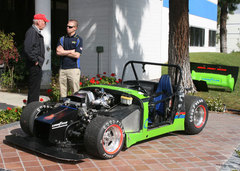 |
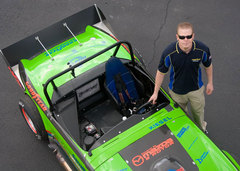 |
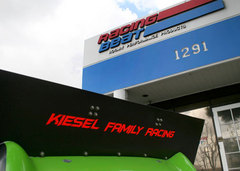 |
It seems that you're willing to share many of your secrets while other competitors are not so willing?
Yes, absolutely! Even if they have problems with something like car setup I'm willing to help them. I helped one of the competitors that came in second place just yesterday, I helped him out with his car setup and he went faster today and almost caught me!
Aren't you then afraid of someone indeed catching you if you share too much information?
No, not all. I think you need to be the best and you should only win if you are the best. If everybody else has the same tools you have and you still beat them - then you're the best.
Your race results are impressive, are you satisfied with the performance of your car or are you looking to go even faster? What's the next improvement you have planned for the car?
I'm happy with the car but we are constantly improving it. This year we've made quite a few changes to increase the performance with both the new turbo and intake manifold. We are planning on working on aero this year with an under tray and rear diffuser, which will help some at our higher speeds. We hit about 80 MPH, with the aero improvements becoming effective at speeds above 60 MPH.
How do different track surfaces impact your preparation for the car?
Here at the El Toro Marine base the runway surface that we run on is the grippiest asphalt lots that I've ever been on. It's similar to concrete and you have to set the car up accordingly. Typically we raise the rear ride height and run a bit more rear rebound, a little less toe-in on the rear. The car tends to pick up a push and doesn't want to turn on throttle and corner exit, so we have to free the car up a bit.
We understand you're working with Goodyear on the development of a DOT approved street tire for use in autocross. Tell us more.
I have been working with Goodyear on the DOT-approved street tire since mid 2008. The tire made its race debue at the San Diego National Tour and brought home wins in every class the tire ran in. Up till this point Hoosier has dominated the market for years and Goodyear wanted to provide a DOT tire that not only outperformed the Hoosier A6 they wanted it to outlast it, to lower the high cost for competitors. So far everybody has been winning on the new Goodyear tire and it has been faster in all of our testing. Some of the testing was performed here at El Toro by 5 multi time SCCA National Champions from around the US. One of the tire testers was the very talented multi-time national champion Andy Mckee, who drives a third-gen RX-7 in Super Street modified class Andy McKee is one of the Goodyear Contract drivers and has been running the Goodyear Eagle RS 315/17's on the car, since the switch Andy has been dominating at every event he has run at.
What is your secret to going fast? What do you do that others don't?
We do a lot of car preparation; we spend a lot of time in the garage and we're constantly checking everything. The key is to not break, so preventative maintenance is critical. I'm usually one of the first guys to the event and I'm one of the last guys to leave. I walk the course a multiple times, take mental notes, and look far ahead when I drive. I try and put the car in the key spots while driving and maximize the grip throughout the run. I have a good understanding of the car and I'm not afraid to make changes and adjustments based on how I want the car to handle.
For someone just getting into autocross, what driving advice would you give them?
I see a lot of people just getting into autocross walk the course and are not paying attention. They're talking with their buddy, talking about the baseball game or what they did last night, they are not concentrating at all.... Tell your buddy to keep quite or walk by yourself and pay attention! Get as many walks as you can, I recommend 4 or 5 walks if possible. If you're new REALLY pay attention to the turns because when you get into the car everything is coming up quick. Get an instructor, go for rides with an instructor or have an instructor drive your car if you can.
What driving advice would you give to a seasoned driver? What bad habits do drivers pickup they might not be aware of?
As people drive their car for a period of time they become "comfortable" and they stop pushing it all the way. You need to be sliding sideways once in awhile, you need to be spinning out every so often, you need to be pushing off the end of the course because you went too fast, you need to hit some cones and take some chances. Of coarse not ALL the time, but you need to be constantly pushing your car and yourself so you know the limits of the car and yourself.
Can most people hop into a fast car and drive fast? How much of the equation is the driver and just how much of it is the car?
If you are racing in a stock autocross class you have limited modifications so every guy has almost the same car. Winning becomes more about the skill of the driver because the cars are so similar. Get into a class like ours and the car is so important, but, since you are in a modified class the cars are so much faster you narrow the window of people that can actually drive the car to its full potential. So, the driver is just as important in the modified class as it is in the stock class, its just that the car becomes a more important role in the modified class than it may be in stock.
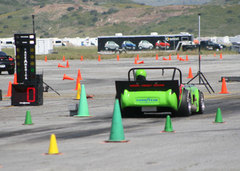 |
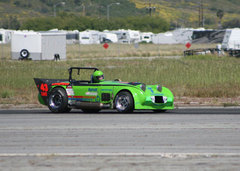 |
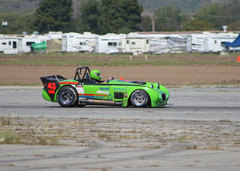 |
Take us through a typical autocross run.
I clear my head and pull up to the starting line and I don't think about anything. I stay calm, I wait, I look at the course... While on a run I don't think about something the car is not doing, if I make a mistake I move on and drive as if I did not make a mistake. I just stay calm and take the course into sections. I Take every run like it's a whole new thing and erase any bad thing that happened on a previous run. Some events there are a lot of that people, some will come up and watch our car run and all of a sudden there's a crowd watching I just focus on what I need to do and stay clam.
During a run I used to get nervous or I'd panic if I blew a corner or hit a cone, then I'd try to drive the car harder to make up for it, but you can't do that. What you need to do it to take each section of the course on its own and if you blow a corner stay cool and drive the rest of the run as you would have driven it prior to the mishap. Not any harder, you can't get 110% out of the car as it can only give you 100%. Forget about that turn, its over, that cone you hit is behind you, you've got to focus and get the rest and get the job done. A lot of people mess up and they overdrive after that, and they go slower and have even more problems.
What's the feeling like when you come across the line? Can you tell when you've had a good run?
(Smiles) Yeah, I know when I've done a good run, I can feel it. How I determine it is if I've had maximum grip everywhere on course, and I know if I have, and I can feel the car just starting to slide, then I know when I come through that I've had a good time - I don't even need to look at the timer.
Have you ever finished a run only to be surprised that you actually ran faster than you thought?
(Laughs) No, never. You know when you've messed up.
Car info
1958 Austin Healey Bugeye Sprite
Builder: Jeff Kiesel
Weight: 1810 (with driver and 120 pounds of Ballast)
Width: 64.5 inches
Wheelbase: 80 inches
Power: 396 HP (@ 7300 RPM) and 308 TQ (@ 5700 RPM) to the wheels at 14.7 PSI of boost (Updated 1/2013)
Motor:
- 13B REW (2 rotor turbo out of a 3rd gen RX-7)
- 9.7 high compression Super Lightweight rotors
- Racing Beat Street port
- Ceramic Apex seals
- GTX3076 Turbo
- Tial 52mm wastegate
- Motec boost controller
- Tial BOV
- 7parts Stainless Manifold
- Coast Fab. 4" Race Exhaust
- Motor built by Jim Mederer of Racing Beat
- 7parts Custom Intercooler
- Racing Beat Aluminum Side Housings
Drivetrain:
- Extreme Duty ACT Clutch (6 puck unsprung)
- Jerico 4spd Road Racing Gearbox from Taylor Race Engineering
- Custom CV shaft Driveshaft
- 1st Gen RX-7 solid axles rear end modified by Speedway Engineering (turning into full floater rear end)
- Custom Moore Performance Axles
- Aluminum midplate engine mounts
Ignition/Fuel/Engine Management:
- Motec Sport Dash Display
- Motec M2R Engine Management System
- (4) LS2 coils
- Aeromotive A1000 Fuel Pump and Fuel Pressure Regulator
- Yaw Power ID2000 2000cc fuel injectors (x4)
- Tuned by Danzio Performance
Suspension:
- Wilwood Brakes
- Tilton 3 Pedal floor mounted set up
- Carbo Tech Panther Plus Brake Pads
- Penskey Triple Adjustable Shocks build by Guy Ankeny of ARE
- 2 1/4" Hyperco springs
- Bogart 3 piece wheels 13 x 10 front and 13x14 rear
- Goodyear Slicks 20x9.5x13 (Front) 23.5x13x13 (Back)
- 7parts tubular adjustable front swaybar
Misc:
- 7parts Carbon Fiber Front and rear Body 1/2's
- 7parts Designed and Built Semi-Tube Frame Chassis
- 7parts Carbon Fiber Rear Spoiler

